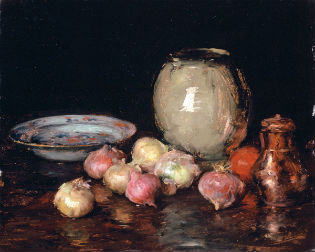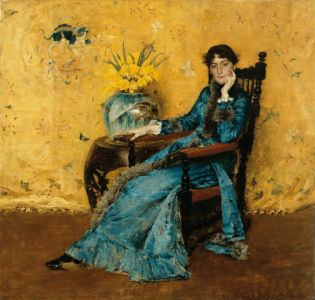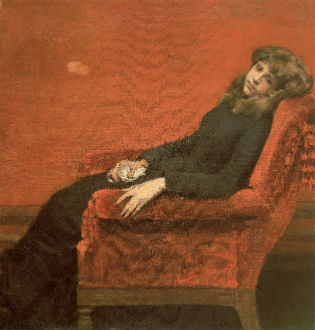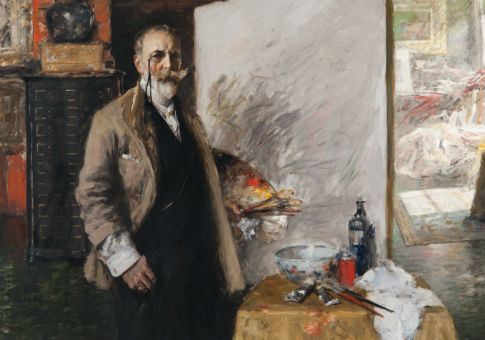If American literature in the nineteenth century can be said to have got underway with the romantic efforts of Longfellow and Hawthorne and to have concluded in the cosmopolitan, trans-Atlantic mode of Henry James, then very much the same observation can be allowed about American painting. Romance, virgin landscapes, the promise of Nature and of America—interchangeable concepts in the eye of a Thomas Cole, say—continue as major themes for Frederic Edwin Church and Albert Bierstadt, but then something happens. America gets rich, not in promise or untapped resources but in the filthy lucre itself; Americans start to travel more; the country turns an acquisitive eye toward the property of dissipating European empires and an admiring eye to Europe itself for style, fashion, culture. And so American painting ends up as a series of illustrations fit for a Henry James novel, produced by the likes of James McNeill Whistler, John Singer Sargent, and William Merritt Chase.

This is all a bit crude, but not that off the mark for its oversimplification. If you wanted to fix the spot on the map where the pivot occurred, or that at the very least was witness to the changing of the guard, your pin should go in on West 10th Street in Manhattan, between 5th Avenue and the Avenue of the Americas—Greenwich Village, a few blocks from Washington Square Park. There stood (before it was demolished for a modern apartment building) the Tenth Street Studio Building. Church and Bierstadt both had studios there, as had Winslow Homer. In 1878, Chase—the subject of a fine exhibition at the Phillips Collection that closes next month—rented a generous space there and turned it into a lavishly decorated showcase for his work, and for objects and textiles that interested him. Chase also used the room, its visitors, and its contents as subjects for some of his most famous work.
James once said of Chase’s contemporary that, "I have always thought Sargent a great painter. He would be greater still if he had one or two little things he hasn’t—but he will do." Surveying the extensive and diverse collection of Chase’s paintings on display at the Phillips, it is hard not to come to a similar conclusion about him. Sargent and Chase, often with their older contemporary Whistler, were frequently mentioned in the same breath by late-nineteenth century critics. All three reflected the same internationalist trend in American art, albeit with important differences among them. All three were influenced by European avant-garde movements, including what came to be known as Impressionism, and by the aestheticist trend that came along with the rejection of academic art, history painting, and the like—"art for art’s sake," as Whistler would have put it.

Of the three, today Chase is perhaps the least well known. He was also the least likely of the group to have come to international prominence in the first place. Born in the center of Indiana in 1849, when that part of the continent had been pure wilderness only a few decades earlier, his family soon moved to Indianapolis. After a spell studying art in New York, he lived with his family in St. Louis; his obvious talent and work ethic inspired the local quality to fund his studies in Europe. Chase picked Munich over Paris—too many distractions—and, by his late twenties, was well on his way to being one of the dominant American painters of his generation.
Perhaps one of the reasons why Chase doesn’t stick in the national mind the way Sargent or Whistler do is because his mature stylistic interests were so peripatetic. One thinks of Whistler and sees (beyond his mother) tonal discipline, subtle gradations of muted colors, Asian decorative motifs. With Sargent, those society portraits (however sick he got of painting them) with their wonderfully persuasive communication of personality, those piercing, intense gazes, the sense that someone’s soul is present on the canvas, come to mind. But there is no one answer to the question, "What is a Chase?" This is a second order issue—a kind of branding problem—that didn’t harm his career in his day, but he’s not the first painter of supreme talent who has a muddled popular legacy because he was a bit of a modal shape-shifter.

The paintings assembled at the Phillips are not the work of a Hudson River School artist—no romantic, potential-stuffed western landscapes here. They are just about everything else, though—a survey of the international subjects of his generation: elegant ladies, domestic scenes, tamed landscapes, cityscapes, still-lifes, and more. They constitute a survey of styles, as well. Chase’s early paintings, like 1877’s ‘Ready for the Ride,’ show the influence of his training in Munich and his skillful recasting of old master techniques, especially those of painters like Velazquez, for contemporary subject matter. The influence of Whistler is clear in 1883’s ‘Portrait of Dora Wheeler’ and 1884’s ‘The Young Orphan’ (two of the most arresting paintings in the exhibition, displayed in the same gallery); 1888’s ‘Hide and Seek’ betrays the influence of Manet and Degas, or even of Caillebotte (another shape-shifter) in his more realist mode. His later paintings of the Shinnecock Hills on Long Island, so real you can almost hear the hot summer afternoons they depict, or still-lifes like the marvelous ‘Just Onions’ (1912), have a common thread in nothing so much as the brilliance of their execution—clever compositions, difficult common objects (like those onions) represented not only persuasively but somehow in an elevated fashion. There is something of Vasari's comment on Piero di Cosimo in the portrayal of these deceptively complicated things: to paint them is the work of an artist "constantly seeking after difficulties."
To observe that Chase has a muddled popular legacy today is of course not to say that he has little legacy, an especially ridiculous claim in his case, considering his reputation as a teacher. Somewhat unusually for a painter of his prominence, he was devoted to the classroom and to students, of whom he had thousands—including, to one extent or another, George Bellows, Georgia O’Keefe, and Edward Hopper. That is quite the bequest in its own right, aside from Chase’s own striking output. So what then causes one to think, as James did of Sargent, that there is something, however little, that is missing? My candidate is that, behind all of this aesthetic luxuriating in texture and color, in the pure pleasure of seeing things, there isn’t much else—by design, but perhaps by unfortunate design. In other painters of his generation, the aesthetic focus doesn't hinder a claim to greatness because they were true innovators in style—but Chase's excellence is in the execution, or perhaps in a thousand tiny innovations, rather than any grand insight that changed the state of the art. Absent that, these paintings remain just very fine pictures of things, with little in the way of further dimensions. As Anthony Powell put it rather crushingly of Sargent: he "remains rather inexplicable, perhaps because there was nothing to explain."
